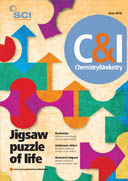With over 70% of the world’s wild fish stocks at risk from over-fishing, aquaculture – the farming of fish, crustaceans and molluscs – is growing to fill the demand gap; half the fish eaten is now farmed. In 2010, 60m t of farmed fish was produced, valued at ca $119bn, according to the UN’s Food and Agriculture Organization (FAO), which estimates that in less than 20 years three quarters of the fish we eat will be farmed.
However, current practices, particularly in Asia and China where 90% of fish is farmed, may be fuelling antibiotic resistance and dangerous pathogens. Catfish and carp in India’s East Kolkata Wetlands, for example, are typically farmed in huge shallow ponds filled with raw, pathogen-rich wastewater, potentially contaminated with heavy metals and other pollutants. ‘Heavy metal tolerance produces robust pathogens and goes hand in hand with antibiotic resistance,’ says Iain Young at the Institute of Integrated Biology at Liverpool University, UK.
Another concern is ‘integrated’ approaches that combine intensively reared chicken or pig production with fish farming – a practice widespread across Asia. Fish are raised in water into which animal manure may be fed to ‘fertilise’ the plankton and plants eaten by fish. Farmed animals are fed antibiotics as growth promoters and to prevent infection, so their manure may contain resistant bacteria. ‘You couldn’t design a better incubator for evolution of antibiotic resistance: take a huge reaction vessel, fill it with agricultural slurry and low levels of antibiotics to promote mutation,’ says Young.
The development and spread of resistance genes and bacteria could devastate fish stocks or infect consumers via contaminated food or fish products. Pathogens may already be antibiotic-resistant when they reach the aquafarms, or acquire resistance through gene transfer. Anyone infected with antibiotic resistant campylobacter, coliforms and salmonella, for example, could easily spread the pathogens by migration or contaminating food. In addition, fish from commercial aquafarms and their byproducts, such as fishmeal and feed additives, are exported worldwide.
Data on the use of antimicrobials are unavailable in most countries and there are no official statistics on types of aquaculture practice. ‘We don’t know how serious the problem is and we do not have enough scientific and technical evidence to pinpoint a serious risk of antibiotic resistance in aquaculture,’ admits Rohana Subasinghe, senior FAO aquaculture officer.
However, in Vietnam, for example, researchers have found resistance to nalidixic acid and enrofloxacin among E. coli and Enterococcus spp. isolated from manure and water-sediment samples in integrated pig–fish farms using feed containing the two antimicrobials (App. Environ. Mic., 2011 doi:10.1128/AEM.02975-10).
Another study by Jawahar Abraham, from West Bengal University of Animal and Fishery Sciences, India, found that human pathogens, such as E. coli, Aeromonas hydrophil and Psuedomonas spp isolated from cultured freshwater fish in Kolkata are resistant to oxytetracycline and nitrofurantoin and that multiple antibiotic resistance is high in catfishes and sewage-fed farm grown carps (Adv. J. Food Sci. and Tech., 2011, 3(1), 69).
More worrying is speculation that aquaculture played a role in development of Kentucky ST198, the new strain of salmonella that is resistant to ciprofloxacin (J. Infect Dis., 2011, 204(5), 675).
There is ‘an urgent need to monitor antibiotic usage in aquaculture, to tackle the threat of antibiotic resistance genes to public health,’ say researchers in China. They found several strains of resistant pathogens in indigenous bacteria in Tianjin, showing that aquaculture farms are a reservoir of antibiotic resistance genes and antibiotic-resistant bacteria (Water Research, 2012, 46, 2355).
In theory, antimicrobial use in aquaculture should comply with the World Health Organization Global Principles, World Organisation for Animal Health Guidelines and Codex Code of Practice to minimise antimicrobial resistance. However, aquaculture was not considered when they were adopted in 2006, and the Codex Code of Practice for Fish and Fishery Products, while providing general guidance on use of veterinary drugs in aquaculture, does not address specific issues related to integrated livestock and fish culture. The reality, admits Subasinghe, is that many farmers adopt a quick fix solution, haphazardly using antibiotics – some of them banned – to control disease.
‘Antibiotic use for aquaculture is supposedly regulated in most countries with particular emphasis on products destined for export markets, but where products are cultured for local or domestic consumption checks are probably not carried out,’ says Stuart Bunting at the School of Biological Sciences at Essex University, UK. Although such matters are discussed in the FAO Committee on Fisheries subcommittee on aquaculture, ‘this has never been raised as an issue by our members so there has not been a debate so far,’ says Subasinghe. ‘No one really believes there is a serious problem.’
Nevertheless, there is a real and increasing problem with antibacterial resistant pathogens causing disease in cultured aquatic fish and shellfish – mainly associated with use of antimicrobials in aquaculture, says Anders Dalsgaard, professor in the department of veterinary disease biology at the University of Copenhagen, Denmark. ‘With regards to impact on human health, the answer is that we do not know at the moment, mainly due to lack of data,’ he says.





